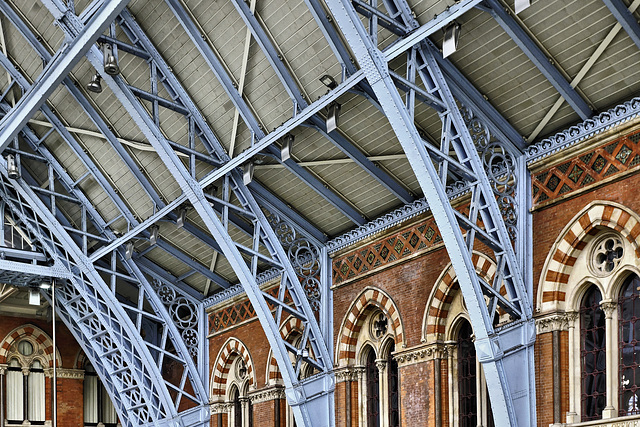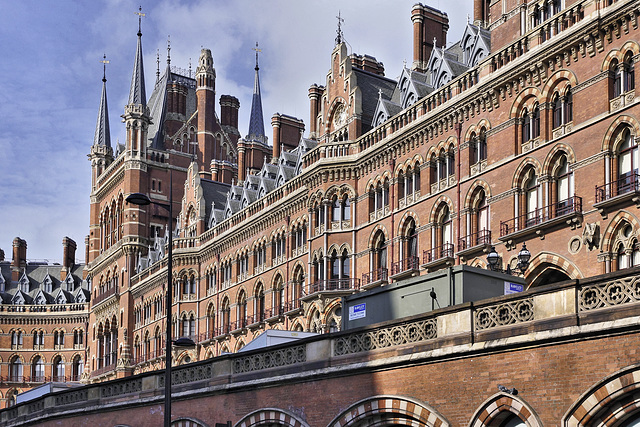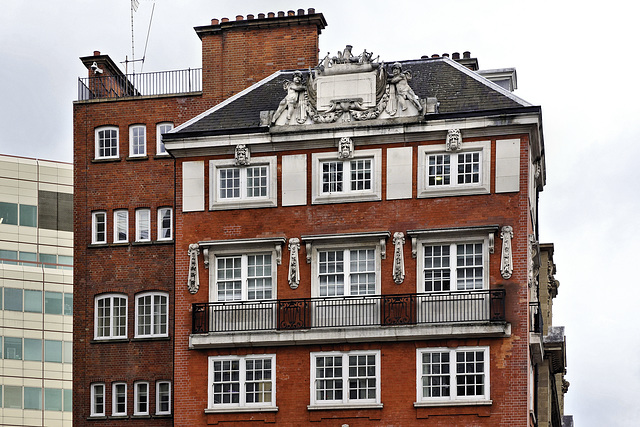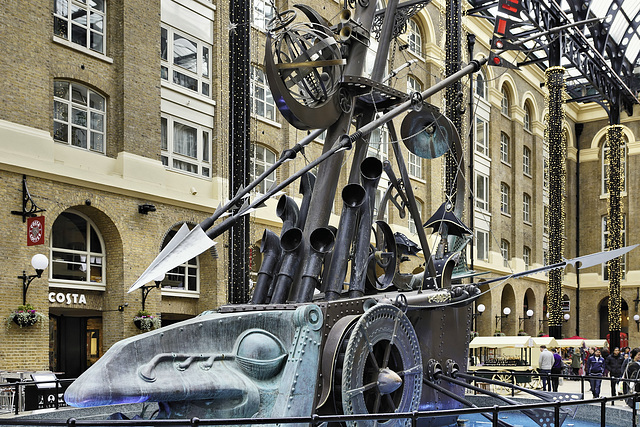Jonathan Cohen's photos
A Cathedral of Steel and Brick – St Pancras Railway Station, Euston Road, London, England
Close-up of the arched cast-iron roof supports at St Pancras International Station
A Truly Grand Hotel – St Pancras Railway Station, Euston Road, London, England
In 1865 the Midland Railway Company held a competition for the design of a 150-bed hotel to be constructed next to its railway station, St Pancras, which was still under construction at the time. Eleven designs were submitted, including one by George Gilbert Scott, which, at 300 rooms, was much bigger and more expensive than the original specifications. Despite this, the company liked his plans and construction began. The east wing opened in 1873, and the rest followed in the spring of 1876. The hotel was expensive, with costly fixtures including a grand staircase, rooms with gold leaf walls and a fireplace in every room. It had many innovative features such as hydraulic lifts, concrete floors, revolving doors and fireproof floor constructions, though (as was the convention of the time) none of the rooms had bathrooms. The hotel was taken over by the London, Midland and Scottish Railway in 1922 before closing in 1935, by which time its utilities were outdated and too costly to maintain, requiring armies of servants to carry chamber pots, tubs, bowls and spittoons.
After closing as a hotel, the building was renamed St Pancras Chambers and used as railway offices, latterly for British Rail. British Rail had hoped to demolish it, but was thwarted in a high-profile campaign by Jane Hughes Fawcett and her colleagues at the Victorian Society, a historic preservationist organization founded in part to preserve the Victorian railway buildings. Officials dubbed Jane Fawcett the "furious Mrs. Fawcett" for her unceasing efforts, and in 1967, the Hotel and the St. Pancras station received Grade I listed status. The building continued its use as rail offices, until the 1980s when it failed fire safety regulations and was shut down. In the 1990's the exterior was restored and made structurally sound at a cost of around £10 million.
Planning permission was granted in 2004 for the building to be redeveloped into a new hotel. The main public rooms of the old Midland Grand were restored, along with some of the bedrooms. The former driveway for taxis entering St. Pancras station, passing under the main tower of the building, was converted into the hotel's lobby. In order to cater for the more modern expectations of guests, a new bedroom wing was constructed on the western side of the Barlow train shed. As redeveloped the hotel contains 244 bedrooms, 2 restaurants, 2 bars, a health and leisure centre, a ballroom, and 20 meeting and function rooms. The architects for the redevelopment were Aedas RHWL. At the same time, the upper floors of the original building were redeveloped as 68 apartments by the Manhattan Loft Corporation. The St. Pancras Renaissance Hotel opened on 14 March 2011 to guests; however, the formal Grand Opening was on 5 May – exactly 138 years after its original opening in 1873.
Railway Clock Towers – St Pancras Railway Station, London, England
... with King's Cross Station in the background.
Denmark House – London Bridge Hospital, Tooley Road, Southwark, London, England
Occupying a commanding position overlooking the River Thames and Tower Bridge, London Bridge Hospital is one of the largest private hospitals in the United Kingdom. One of its component buildings is Denmark House which was built in 1900 as shipping and general offices. At roof level, a memory of this past use is preserved by a large relief sculpture showing a merchant ship. The building’s extensive cellars were used for storage of a variety of items, including the Czar of Russia’s silver reserves (which later became those of the nascent Soviet state). When necessary, the silver was shipped out of the building in a plain-looking bread delivery van. In earlier times, Tooley Street had been a route of pilgrimage to Bermondsey Abbey; crossing various fish-filled streams, and fronted by a whole series of large church palaces, as well as the riverside town houses of the church dignitaries. In the eighteenth and nineteenth centuries, Tooley Street became a dock road, serving the giant warehouses of the Pool of London which were used to bring in a variety of food products which led to this side of the Pool of London becoming known as the "Larder of London."
"The Navigators" #3 – Hay’s Galleria, Southwark, London, England
A rivet-covered bronze sculpture with the face of a man and the body of an industrial-age ship, The Navigators is actually an enormous kinetic machine. The 60-foot sculpture by artist David Kemp was installed in 1987 during the renovation of Hay’s Galleria, which saw the conversion of the old wharf into a shopping center. When activated, its oars move through the water at its sides.
The history of Hay’s Galleria dates back to the 1600s and was originally known as Hay’s Wharf, after the original owner of a brewery at the location. Located on the Thames, over the centuries it has been a center of trade and shipping until heavy damage from bombing raids during the Second World War nearly destroyed it. By the 1960s it had fallen into disrepair. In the 1980s the property was restored and converted, and enclosed under a glass roof with Kemp’s sculpture installed as a tribute to its working class past.
Kemp is a British artist best known for his large assemblage sculptures. He lives on the Atlantic coast of West Cornwall where he scavenges for interesting bits from which to make his art. About his art he says: "I make things out of things, big things, little things, old things and new things. I like to recycle things, and find new uses for things that have been thrown away. Some things say something about their surroundings, and other things become something else." The Navigators was one of Kemp’s first major public installations. Since then, he has created a number of large works including the "Old Transformers," a pair of huge outdoor sculptures near Consett, County Durham.
"The Navigators" #2 – Hay’s Galleria, Southwark, London, England
A rivet-covered bronze sculpture with the face of a man and the body of an industrial-age ship, The Navigators is actually an enormous kinetic machine. The 60-foot sculpture by artist David Kemp was installed in 1987 during the renovation of Hay’s Galleria, which saw the conversion of the old wharf into a shopping center. When activated, its oars move through the water at its sides.
The history of Hay’s Galleria dates back to the 1600s and was originally known as Hay’s Wharf, after the original owner of a brewery at the location. Located on the Thames, over the centuries it has been a center of trade and shipping until heavy damage from bombing raids during the Second World War nearly destroyed it. By the 1960s it had fallen into disrepair. In the 1980s the property was restored and converted, and enclosed under a glass roof with Kemp’s sculpture installed as a tribute to its working class past.
Kemp is a British artist best known for his large assemblage sculptures. He lives on the Atlantic coast of West Cornwall where he scavenges for interesting bits from which to make his art. About his art he says: "I make things out of things, big things, little things, old things and new things. I like to recycle things, and find new uses for things that have been thrown away. Some things say something about their surroundings, and other things become something else." The Navigators was one of Kemp’s first major public installations. Since then, he has created a number of large works including the "Old Transformers," a pair of huge outdoor sculptures near Consett, County Durham.
"The Navigators" #1 – Hay’s Galleria, Southwark, London, England
A rivet-covered bronze sculpture with the face of a man and the body of an industrial-age ship, The Navigators is actually an enormous kinetic machine. The 60-foot sculpture by artist David Kemp was installed in 1987 during the renovation of Hay’s Galleria, which saw the conversion of the old wharf into a shopping center. When activated, its oars move through the water at its sides.
The history of Hay’s Galleria dates back to the 1600s and was originally known as Hay’s Wharf, after the original owner of a brewery at the location. Located on the Thames, over the centuries it has been a center of trade and shipping until heavy damage from bombing raids during the Second World War nearly destroyed it. By the 1960s it had fallen into disrepair. In the 1980s the property was restored and converted, and enclosed under a glass roof with Kemp’s sculpture installed as a tribute to its working class past.
Kemp is a British artist best known for his large assemblage sculptures. He lives on the Atlantic coast of West Cornwall where he scavenges for interesting bits from which to make his art. About his art he says: "I make things out of things, big things, little things, old things and new things. I like to recycle things, and find new uses for things that have been thrown away. Some things say something about their surroundings, and other things become something else." The Navigators was one of Kemp’s first major public installations. Since then, he has created a number of large works including the "Old Transformers," a pair of huge outdoor sculptures near Consett, County Durham.
Tower Bridge – London, England
Tower Bridge is a combined bascule (drawbridge) and suspension bridge in London built in 1886–1894. The bridge crosses the River Thames close to the Tower of London and has become an iconic symbol of London. The bridge consists of two bridge towers tied together at the upper level by two horizontal walkways, designed to withstand the horizontal tension forces exerted by the suspended sections of the bridge on the landward sides of the towers. The bridge deck is freely accessible to both vehicles and pedestrians, whereas the bridge’s twin towers, high-level walkways and Victorian engine rooms form part of the Tower Bridge Exhibition, for which an admission charge is made.
In the second half of the 19th century, increased commercial development in the East End of London led to a requirement for a new river crossing downstream of London Bridge. A traditional fixed bridge at street level could not be built because it would cut off access by sailing ships to the port facilities in the Pool of London, between London Bridge and the Tower of London. Construction started in 1886 and took eight years. The bridge was officially opened on 30 June 1894 by The Prince of Wales (the future King Edward VII), and his wife, The Princess of Wales (Alexandra of Denmark). The bridge connected Iron Gate, on the north bank of the river, with Horselydown Lane, on the south – now known as Tower Bridge Approach and Tower Bridge Road, respectively. Until the bridge was opened, the Tower Subway – 400 m to the west – was the shortest way to cross the river from Tower Hill to Tooley Street in Southwark. Opened in 1870, Tower Subway was among the world’s earliest underground ("tube") railways, but it closed after just three months and was re-opened as a pedestrian foot tunnel. Once Tower Bridge was open, the majority of foot traffic transferred to using the bridge, there being no toll to pay to use it. Having lost most of its income, the tunnel was closed in 1898. The high-level open air walkways between the towers gained an unpleasant reputation as a haunt for prostitutes and pickpockets; as they were only accessible by stairs they were seldom used by regular pedestrians, and were closed in 1910.
Jump to top
- ipernity © 2007-2025
- Help & Contact
|
Club news
|
About ipernity
|
History |
ipernity Club & Prices |
Guide of good conduct
Donate | Group guidelines | Privacy policy | Terms of use | Statutes | In memoria -
Facebook
Twitter










